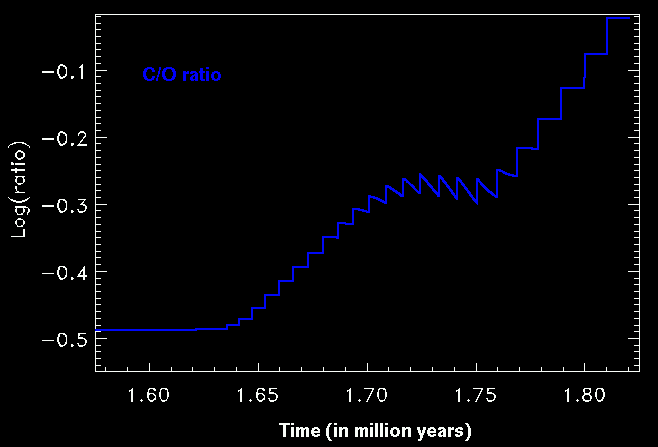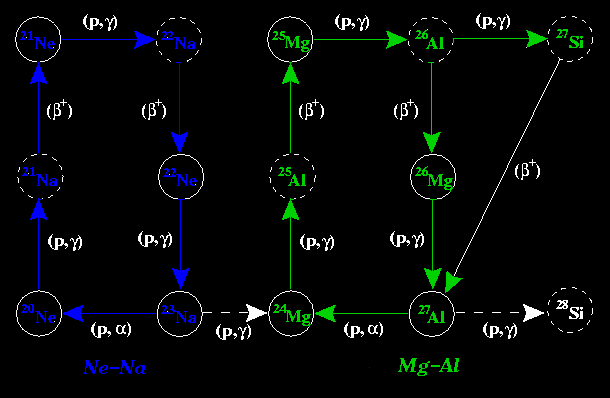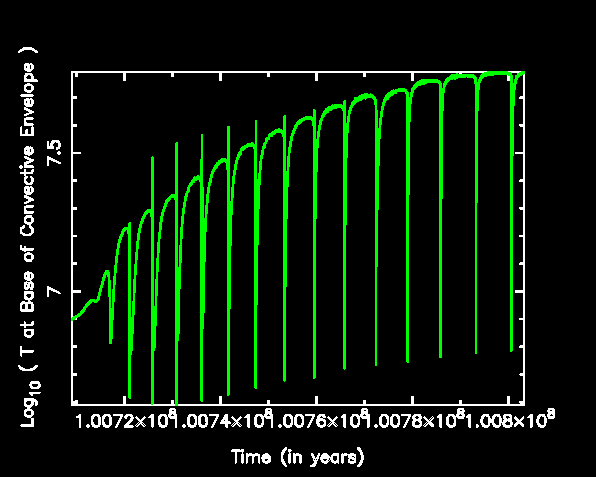Thermal Pulses
-
Making C-12
- We have seen how the thermal pulses produce C-12, and how the following dredge-up then mixes this to the surface. This is the simplest and perhaps the most important of the nucleosynthesis occurring in AGB stars! But there is much more happening, which we discuss here also.
- On the observational side, we recall that most stars have more O-16 than C-12. But repeated thermal pulses preferentially add C-12 to the surface, so that eventually, if the third dredge-up continues, we can have the C-12 atoms outnumbering the O-16. We then have what is known as "Carbon Star". These are indeed observed, on the AGB, at the higher luminosities, indicating that they have experienced many thermal pulses prior to their reaching Carbon Star status. There are still some lingering doubts about the making Carbon stars of the lowest luminosities observed, however.
-
Neutron Captures: the s-process
- Please see the full version of the tutorial for this section.
-
Making F-19
- AGB stars are also believed to be prime sources of F-19. Observationally there is a clear correlation between F/O and C/O. Since the latter derives from thermal pulses, we expect the former will also. But how?
- The beginning of F-19 production is the same as for C-13. We need some H mixed into the intershell region. But we also will need some protons, which can come from (n,p) reactions on N-14 and Al-26, mostly. The schematic movie shows the F-19 production mechanism, through the production of N-15. The main problems are that some of the reactions can occur in the intershell region, and some can occur in the convective shell itself. And F-19 is easily destroyed, too! Its a complicated story: see the various papers by Nami Mowlawi to get the story straight!
- Here is a schematic summary of the F-19 production

- Further details are available in the full version of the tutorial, including examples of reaction rates at various places in the star.
-
Ne, Na, Mg, Al....
- We have seen how these stars can produce Ne-22. But this Ne-22
is also a source for further reactions, if the temperature on the
intershell region is hot enough:

- Then, during dredge-up, these isotopes of Mg are mixed to the surface. Dramatically non-solar abundances can result from this process!
- The rates figures mentioned above also show the production of the Mg isotopes
- The next movie shows the production of the Mg isotopes during a thermal pulse.
- Also, any Ne-22 that is not destroyed and is dredged to the envelope can then be processed by the H-shell into Na-23.
- Likewise, and Mg-25 or Mg-26 in the envelope can be processed to Al-26 and Al-27 (respectively) by proton captures in the H-shell. Although a reasonable amount of Al-26 can be produced in this way, Al-26 is quite a strong neutron poison, so that at the next pulse it is destroyed via (n,p) reactions (the same ones needed to make protons for F-19....) This is shown in the following movie.
Hot Bottom Burning
- And to make matters even more complicated, if the mass of the star is sufficiently high (about 4 or 5 Msun at solar composition, but decreasing as the metallicity decreases) the bottom of the deep convective envelope actually penetrates the top of the H-shell. Hence nucleosynthesis occurs at the bottom of the convective envelope itself. This is known as "Hot Bottom Burning".
- Here is the time dependence of the temperature at the bottom of the convective envelope of out 5Msun model. Note that values near 10^8K are reached!
-
Li Production
- The first thing to happen is that Li-7 is produced via the
Cameron-Fowler Beryllium Transport Mechanism. This is basically P chains plus
convection! The idea being to start the pp chains, to make Be-7 (see below)
and then to use convection to move the Be-7 away from the hot region before
it can complete the PPII or PPIII chains.

- Further details are available in the full version of the tutorial.
- Notice that the observed abundances, shown here in blue, match very well the models!
-
CNO Cycling
- Of course, Hot Bottom Burning does other things too. For a start,
it will be burning H via the CN cycles. This will t urn C-12 into C-13
and N-14.
But we are adding C-12 at each pulse. This is what makes a Carbon star.
But if HBB is active, then the added C-12 can be burned into N-14 and the
star will
not become a carbon star after all!

Here we see the C/O ratio decreasing once the HBB starts!

The C13 content increases with the C12 abundance, due to the processing of C12 into C13. In extreme cases, when the entire envelope can be processed many time between the pulses, then HBB can produce the equilibrium ratio of C12/C13 about 3.5. And a consequence of this burning is the copious production of primary N-14.
- The full version contains plots for M=4, 5 and 6 Msun each with Z=0.02 (solar), Z=0.008 (Large Magellanic Cloud) and Z=0.004 (Small Magellanic Cloud).
- C/O plot showing that HBB prevents the occurrence of C stars. In fact, however, once the mass-loss gets going and the envelope mass is decreased substantially, then the HBB ceases and the dredge-up continues. So sometimes a C-star can still form, albeit briefly and at the end of the star's life (when it is not visible because of the lost mass obscuring it from view). The diagram has the region corresponding to C stars (C/O > 1) shown in magenta.
- C-12/C-13 plot showing equilibrium values when HBB dominates.
- N-14 plot showing lots of N-14 made when HBB exists.
-
Ne-Na and Mg-Al Cycles
- And it doesn't stop there. At these high temperatures we also
have activation of the Ne-Na and Mg-Al cycles, as shown below. Note that
these cycles affect the production of these elements in addition to
their production and destruction in the He shell, and subsequent dredge-up.

- And this movie, although rather complicated, shows the production of Ne, Na, Mg and Al both through dredge-up as well as HBB.
- Much more information on this topic is available in the full version of the tutorial.
-
Summary
- This brief survey has been designed to illustrate the principles of nucleosynthesis (and AGB evolution). The details are quite another matter, of course.
- Please note: this section is very heavily reduced in this demo version. For the full version please contact Cantanout Limited.

